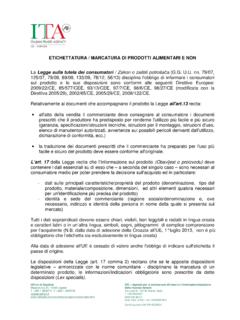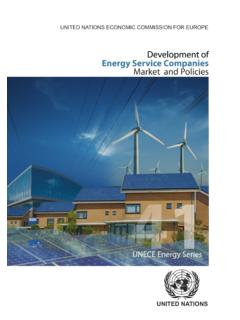Transcription of Kuwait Utilities Sector - infoMercatiEsteri
1 Kuwait Investment Sector P a g e | 1 Industry Research Kuwait Utilities Sector Summary Kuwait has one of the highest per capita energy consumption in the world. According to Global Footprint Network, an average Kuwaiti uses 22 times more resources than the country provides per person. Apart from extreme weather conditions, there are several other reasons for the high energy consumption in Kuwait ; one of the primary reasons being the heavily subsidized cost of electricity. Electricity in Kuwait is charged at two fils per kWh, which is a fraction of the 38 fils it costs to produce.
2 This comes as prices have remained the same since 1966 when it was slashed from 27 fils per kWh. The country s budget for the fiscal year 2012/2013 lists the total government subsidy for consumer services at KWD billion. Out of this, KWD billion goes towards electricity. Moreover, electricity consumption in the overall gulf region is relatively higher because of the energy -intensive water desalination plants, which filter salt water into fresh water. The increasing population in Kuwait and the scarce water resources puts excessive pressure on both electric as well as water Utilities to increase their output with higher investments in new plants.
3 The Ministry of Electricity and Water (MEW) is the sole supplier of electricity and water resources in Kuwait . It is also the central regulatory body that manages the supply/demand situation of these two scarce resources in the country. According to the statistics from the MEW, the rate of energy production almost doubled over the past decade in order to cater to the increasing consumption that is fuelled by the rapid growth of Kuwait 's private and public sectors over the years. With record high energy consumption at the onset of summer 2013, it is absolutely crucial that the country prepares itself to overcome any kind of electricity shortage.
4 On the other hand, the water utility section has to prepare for future growth in water consumption, with the help of new water treatment facilities and water desalination plants. A diverse, long-term water treatment and management plan is the only way to guard against dwindling supplies. As an effort to improve the ties between the GCC countries as well as to better manage excess/shortage of electricity, the six countries in the GCC formed the GCC Interconnection Authority (GCCIA) with a primary objective to increase cross-border electricity supply.
5 The electricity network has helped share electricity reserves and act as a catalyst to exchange energy whenever required during emergencies. Analyst Contact: Mohammad Junaid Ansari Senior Credit Analyst +965 2244-3524 (Ext- 109) Capital Standards (CSR) Gravity Tower, 8th Floor Ahmad Al-Jaber Street, Box 26620 Safat - 13127 Kuwait Office: +965 2244-3523 Email: Report Contents Summary GCC Utilities Sector Utilities in Kuwait Nuclear energy Conclusion June 2013 Kuwait Investment Sector P a g e | 2 Industry Research GCC Utilities Sector The GCC region accounts for one of the highest consumption of power and water resources as compared to other regions of the world.
6 Demand for electricity has been growing at more than 8 per cent per annum for the past several years for most of the GCC member countries. However, despite the high consumption, the region has never faced acute extended shortages of these resources due to several factors that include long term planning at the initial stages, timely implementation of expansion plans as well as abundant resources at the disposal of the government. The financially strong governments with years of budget surpluses also enable them to heavily subsidize these resources.
7 The amount of subsidies spent by different countries are shown in the below exhibit, with four out of the 6 GCC member countries making it to the top five spenders. Exhibit 1: Top 25 countries in terms of fossil fuel subsidies Source : World Bank The members of the GCC are in the process of reforming the power and water Sector . Each country is at a different stage of these reforms, with the main objective of improving future supplies, private Sector participation that will lead to reduction in costs as well as for sharing the financial burden and better regulations to avoid exploitation of consumers.
8 Moreover, as the countries strive towards diversification of the economy towards the non-oil Sector , there is an implied pressure to maintain sufficient resources to cover future requirements. Some countries have also committed billions in the development of clean and sustainable energy . The region is now home to a number of conferences, especially to discuss and pool in expertise from participating international power companies to develop the energy Sector . The 11th Power-Gen Middle East conference in Doha, Qatar, projected that the GCC countries are expected to infuse more than $63 billion into electricity projects over the next five years and installed capacity is likely to reach 170,000 Mega Watts (MW) by 2019.
9 According to a recent study by Apicorp, the GCC is projected to record the highest power demand growth of around percent in the region in 69 70 91 144 150 205 216 246 253 283 297 359 372 379 449 487 723 920 1,102 1,115 1,159 2,291 3,622 3,729 4,172 0 500 1,000 1,500 2,000 2,500 3,000 3,500 4,000 4,500 Angola Taiwan Indonesia Mexico Thailand Ukraine Azerbaijan Argentina Malaysia Russia Egypt Kazakhstan Algeria Ecuador Uzbekistan Libya Iraq Venezuela Iran Turkmenistan Brunei Saudi Arabia Qatar Kuwait UAE Fossil Fuel Consumption Subsidies Per Person (USD), 2011 Kuwait Investment Sector P a g e | 3 Industry Research the medium term in order to meet the massive requirements for water desalination and air conditioning.
10 Moreover, nearly 200 power projects are on the agenda to be implemented over near future. On the other hand, despite being one of the hottest regions in the world, with scare water resources, the GCC region accounts for one of the highest water consumption levels as low costs lead to wastage and extensive usage. In addition, there are very few water bodies in the region and the primary source of potable water are the fossil ground water resources and the desalination plants. As it becomes difficult to extract ground water, the authorities are now focusing on establishing increasing number of water desalination plants.





